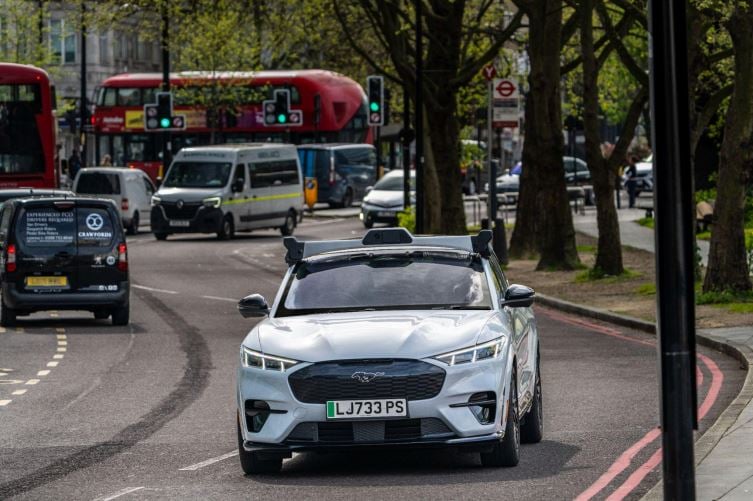The Government is claiming that self-driving vehicles could be on British roads by 2026, after its Automated Vehicles (AV) Act became law.
Originally announced in the King’s Speech in November 2023, the new law aims to put Britain at the forefront of self-driving technology regulation.
Road safety is central to the new legislation, with automated vehicles expected to improve road safety by reducing human error, which the Department for Transport (DfT) says contributes to 88% of road collisions.
The new law will require self-driving vehicles to achieve a level of safety at least as high as careful and competent human drivers, as well as meeting "rigorous" safety checks before being allowed onto roads.
As a result, the DfT says that deaths and injuries from drink driving, speeding, tiredness and inattention could be drastically reduced in the future.
Transport secretary Mark Harper said: “Britain stands at the threshold of an automotive revolution, and this new law is a milestone moment for our self-driving industry which has the potential to change the way we travel forever.
“While this doesn’t take away people’s ability to choose to drive themselves, our landmark legislation means self-driving vehicles can be rolled out on British roads as soon as 2026, in a real boost to both safety and our economy.”
The Society of Motor Manufacturers and Traders (SMMT) says that self-driving technology could help save 3,900 lives and prevent 60,000 serious accidents.
In a SMMT report published last November, the trade body also said it has the potential to deliver a £66 billion boost to the economy by 2040.
The AV Act follows self-driving trials already taking place across the country. For example, home-grown British success stories Wayve and Oxa are trialling self-driving cars in London and Oxford.
Paul Newman, founder and chief technology officer of Oxa, said: “The immense work put in by the DfT, Law Commissions and CCAV in crafting the Automated Vehicles Bill has helped it pass into law with the strongest cross-party backing.
“We now have autonomous vehicle legislation which is more comprehensive in scope and clearer in its requirements than in any other country.
“The Act gives the UK new momentum as developers like Oxa will need to comply with the world’s most comprehensive autonomous vehicle laws to deploy technology in vehicles here.
“Meeting the highest AV standards will make British companies global leaders with technology that is the safest and AI systems the most trusted - all key to building business and public trust in autonomy globally.”
This month it was revealed Wayve had secured more than $1 billion in investment to develop its AI technology further here in the UK.
Wayve has said that their technological advancements have been supported by the UK’s Code of Practice: Automated Vehicle Trialling, which sets out a clear framework to support and promote the safe trailing of self-driving vehicle technology.

Alex Kendall, co-founder and CEO of Wayve, said: “I am delighted that the Automated Vehicles Bill has received Royal Assent.
“This is a critical milestone for the UK’s deployment of self-driving technology and cements the UK as a global leader in regulating this sector.
“We are grateful to the Government and all who have engaged with us in the conversation about the importance of this legislation.”
He explained: “Self-driving technology promises a safer, smarter and more sustainable future of transport.
“There’s still some way to go with secondary legislation before we can reap the full benefits of self-driving vehicles in the UK, but we are confident the Government will prioritise these next steps so this technology can be deployed as soon as possible.”
Between 2018 and 2022, the UK self-driving vehicle sector alone generated £475 million of direct investment and created 1,500 new jobs.
The Act delivers a legal framework, setting out who is liable for AVs, meaning that drivers can be assured that while their vehicle is in self-driving mode, they will not be held responsible for how the vehicle drives.
For the first time, corporations such as insurance providers, software developers and automotive manufacturers can assume this responsibility.
To ensure these vehicles are safe for British roads, the vehicle approval system will be supported by a completely independent incident investigation function.
Companies will have ongoing obligations to keep their vehicles safe and ensure that they continue to drive in accordance with British laws.
Mike Hawes, SMMT chief executive, says that the new legislation is a “watershed moment for UK automotive innovation and road safety”.
“Self-driving vehicles will revolutionise our society, and this new law will help turn ambition into reality, putting the UK alongside a handful of other global markets that already have their regulatory frameworks in place,” he added.
“The industry will continue its close collaboration with Government and other stakeholders to develop the necessary secondary legislation that will enable the safe and responsible commercial rollout of self-driving vehicles and the significant social and economic benefits they will afford the UK.”
The passage of the new law follows consistent Government backing of the self-driving vehicle industry – with more than £600m in joint Government and industry investment since 2015.
This funding has helped create innovative new companies, build the AV supply chain and lay the groundwork for the early commercial market, says DfT.
Public confidence in technology key
Richard Cuerden, director at the Transport Research Laboratory (TRL), says that the automated technology, software and sensors, and the business models to deliver new services, are developing fast.
“By setting a regulatory framework, the Government is providing the industry with confidence and motivation to continue to, and we expect to increase investment in the UK, in this growing sector,” he said.
“The promise is more accessible, safer and greener journeys for goods and people, and at TRL we are working hard to ensure that this is delivered.
“The commercial success will only be possible if the public has trust in the technology and chooses to use AVs.
“Here safety is key and we are working hard to develop safe engineering and system requirements, and in parallel recognising that it is as important to provide public confidence.”
That need to gain public confidence in the technology was echoed by the RAC. Head of policy Simon Williams said: “This is a major step on the road to autonomous vehicles appearing on the UK’s roads. But there’s lots of work still to do, not least bringing drivers along on the journey.”
RAC research conducted last year showed 58% of drivers are scared by the idea of fully autonomous vehicles and just 15% think they’ll make the roads safer, which suggests that there needs to be a real culture change if the public are to fully embrace them.
He added: “There are also some very practical hurdles to overcome, such as how the cars of tomorrow will be able to successfully and safely navigate the UK’s complex web of streets – especially with so many potholes and faded road markings.”
Dr Rana Charara, strategic marketing leader, automotive and IoT at Trimble, recently took a look at the potential of self-driving vehicles for fleets in an opinion piece for Fleet News.
“The technology at the forefront of self-driving vehicles is already in use and fully capable of supporting more autonomy,” she said.
“A suite of sensors, augmented satellite signals, and ever-learning AI software can ensure geographic data accuracy of up to a few centimetres on the road.
“Assuming the law is fairly applied; and industries and technologies certified, regulated, and strictly licensed by all actors involved, the level of autonomy can safely be increased on UK roads.
“However, it won’t be easy or simple. Moving to level 4 and 5 will include busy, dynamic, urban environments - and autonomy in these contexts is much harder to plan for.
“Some infrastructure may need to be re-designed, cities made smarter and perhaps even digitally interconnected, and ideally, 5G coverage extended.”
The Highway Code will also need to be considered; for example, how will an autonomous car react when it has to technically break the law by crossing into the other lane to overtake a cyclist?
“These are all questions that will need clarifying with all stakeholders involved,” said Charara.
“This Bill, however, is a good start - and doesn’t try to minimise the complexity of the mammoth task ahead. It stipulates that much more discussion between many people will be needed, and that many more details will need to be decided by secondary legislation down the line. This is a flexibility that’s vital for regulating such a complex and fast-moving technology.”






















martinwinlow - 23/05/2024 10:45
"The Highway Code will also need to be considered; for example, how will an autonomous car react when it has to technically break the law by crossing into the other lane to overtake a cyclist?" The same way a human does and which is covered by the Highway Code anyway... "129 - You may cross the (solid white) line if necessary, provided the road is clear, to pass a stationary vehicle, or overtake a pedal cycle, horse or road maintenance vehicle, if they are travelling at 10 mph (16 km/h) or less."